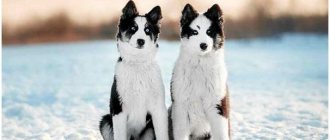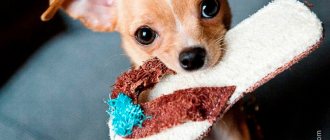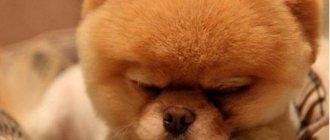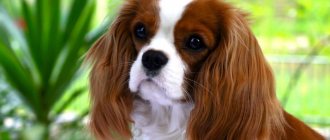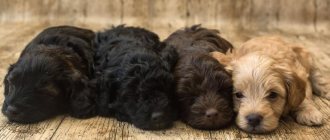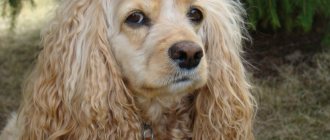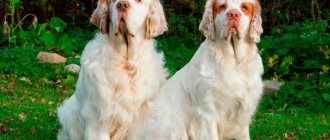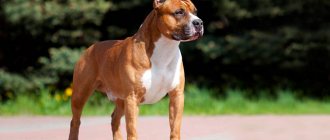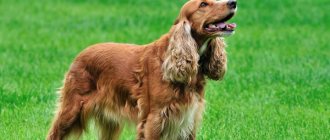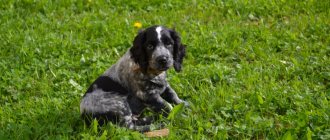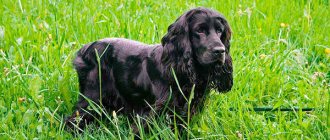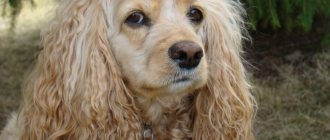Spaniels are a group of hunting dogs for catching water and land game. Modern dogs are less adapted to their main job, but remain loyal friends, cheerful, kind pets, and children's favorites. Many believe that the true homeland of Spaniels is England, but in fact the first hunters appeared in the Spanish lands.
Any spaniel needs training and education, careful grooming, and proper selection of food. You should not choose a breed from this group if the family is not ready for frequent active walking.
English cocker spaniel
This species was bred in England in the 19th century and was intended for hunting game. The spaniel turned out to be well-built, muscular, its height reaches 36 cm, and its weight reaches 10 kg. The dog can be kept in an apartment, but it is important to take it for walks often and exercise it physically. The Cocker is very affectionate and sociable, gets along well with children. Even an inexperienced owner can keep a pet. Kennels where you can buy a cocker:
- Pride of the Urals (Ekaterinburg);
- Alfa Gold (Moscow);
- Kingdom of redheads (Krasnodar).
The price for a puppy starts from 5,000 rubles. In this case, the offspring of titled parents will cost at least 10,000.
History of the origin of the breed group
There are 3 versions of the origin of the breed. Less popular ones include Roman and Celtic. According to the first, dogs came to England along with the ancient Romans, and according to the second, along with the Celtic tribes.
Most dog handlers are inclined to version No. 3, according to which the animals were bred in Spain during the Middle Ages. It was from there that they spread to other European countries, including England.
This version is confirmed by the treatises of the English nobleman Edward of Norwich, a favorite of Richard II, and the English physician John Caius, who stood at the origins of one of the Cambridge colleges.
Despite the fact that the first written mentions of spaniels date back to the 14th century, their breeding began only in the 18th century. The idea of creating their own breed was taken up not only in England, but also in adjacent France, Germany and Holland. In the 19th century, 5 main varieties were presented at the exhibition, which were adapted to hunting in different areas and for different game.
Russian Spaniel
It arose through the efforts of breeders who tried to adapt the breed to Russian conditions. It has an elongated body and long legs, making it easy to gallop. The smoothest of all representatives of the breed. It is distinguished by its endurance, therefore it is a sought-after hunting dog. It is not advisable to keep it in an apartment, as the animal needs to move a lot. The optimal place for it would be a private house. List of kennels selling Russian spaniel:
- Dakel Tessa (Moscow);
- Forest Hunter (Moscow);
- New generation (Kyiv, Ukraine).
The price for a puppy starts from 6,000-8,000 rubles.
Diseases and health problems
There are no serious genetic diseases observed in Russian spaniels, but they are susceptible to various types of infections, like all other four-legged animals. Those dogs that frequently dive under water while hunting can become infected with leptospirosis, a disease that affects the liver and kidneys. Various fungal diseases and parasitic infections are also not alien to spaniels (dermatomycosis, helminthiasis, toxoplasmosis).
Due to their long, floppy ears, spaniels often develop otitis media. Those dogs that often swim in ponds suffer from it much more often, because water can get into the ear canal, leading to inevitable inflammation. These dogs, like people, are prone to quickly gaining unnecessary pounds and getting fat, so you need to keep their diet balanced. It is not uncommon for spaniels to have allergies to various foods, so you need to select food very carefully.
It is worth remembering that all diseases can be stopped or completely prevented. To do this, you need to be more attentive to your dog. Carry out frequent inspections of its appearance, monitor the proper condition of the coat, and prevent its tangling and formation of tangles. The mood of your four-legged friends is also important. If the dog is experiencing any anxiety, it may become nervous or depressed, all of which should always be monitored with maximum care and patience.
Regular preventative examinations at the veterinary clinic also play an important role in the well-being of your pet. Timely completion of all necessary vaccinations, vaccinations, deworming and treatment for parasites will ensure that your furry pet will delight for many years, bringing a lot of wonderful and unforgettable emotions.
American Cocker Spaniel
The ancestor of the American Spaniel is considered to be the English version of the breed. The American is smaller in size, and its distinctive feature is its sculpted head. It has long soft fur. The most common colors are black, fawn and chocolate. This type of spaniel is easy to train, as it has great natural intelligence.
The American Spaniel is considered a long-liver among its relatives. Its lifespan can reach more than 15 years.
Nurseries:
- Redwind Show (Ekaterinburg);
- Evelweiss (St. Petersburg);
- Bonisher (Nizhny Novgorod).
The price for a puppy starts from 15,000 rubles. For this amount you can purchase an animal without a pedigree and not ready to participate in exhibitions. Titled spaniels can cost from 30,000 rubles.
Character traits
All ancient and modern types of spaniels differ in the shape of the sternum, height, color and external characteristics. The breed has a strong skeleton, a medium-sized body, well-developed muscles, an arched chest, and a rounded skull. The forehead smoothly transitions to the nose. The eye shape is oval. The business card is hanging ears with a wide fit.
Popular types are American and English. Dogs have similar external characteristics and disposition. Training and education are carried out according to the same scheme. The American branch of the family can be recognized by its silky long coat and round head.
Americans are 2-3 cm shorter than the British. The latter have short hair and long paws, which help them get into hard-to-reach places and thickets. There are no height limits; the main criterion is weight – no heavier than 15 kg. For both types of spaniels, proportion is more important.
Tibetan Spaniel
The history of this breed originates in China. Dogs reach no more than 6 kg, and their height is about 24 cm. Tibetan spaniels do not trust strangers too much, but they are very attached to their owners. The pet will cope well with the role of a security guard; some representatives even participate in fighting competitions. In general, dogs are cheerful, playful, and enjoy engaging in various types of physical activity. Nurseries:
- Pearl of Ingria (St. Petersburg);
- Sadko Gems (Moscow);
- Vilex Spence (Solnechnogorsk, Moscow region).
The cost of a puppy with an impressive pedigree can cost 40,000-45,000 rubles.
There are few nurseries in Russia that breed Tibetan spaniels. Fans of the breed have to purchase them in Finland or Estonia.
Education and training
It is impossible to force an English Cocker Spaniel to study under pressure, but it is very easy to interest him in a new, unusual activity. Cockers are simply driven by physical activity, so they learn best from lessons that involve reasonable physical activity and are presented in a playful way. This breed’s intelligence is also fine, so it won’t take much time to master basic command techniques, but classes should not be long and monotonously repetitive - this way the dog will quickly lose interest in them.
Master, take the leash
Raising an English cocker begins with its socialization. At 2-3 months, the baby needs to be taught to observe subordination and etiquette, as well as overcome fear of strangers. Possessing gourmet inclinations and a keen sense of smell, small English cocker spaniels love to watch their owner eat, while simultaneously managing to play the role of a hungry sufferer. Do not fall for such shows and under no circumstances treat the pretender with food from your own table. Each such concession reduces your authority in the eyes of the dog, which quickly begins to understand how to apply pressure to get what it wants. It is also better to avoid extremes. An authoritarian parenting style for a puppy is just as harmful as excessive lisp. Teach your pet basic commands unobtrusively, but persistently and systematically.
Despite their cute appearance, English cocker spaniels are no strangers to leadership habits. Usually a wave of independence hits puppies at the age of 3-4 months. During this period, the dog tries to take the position of head of the house, displacing the owner. If you don’t want to find yourself under the thumb of a shaggy dominant, you’ll have to prove your worth to him hourly. The methods can be very different. In particular, during walks it is better to “extinguish” your pet’s emotional outbursts. Use prohibitions more often in everyday life, and also do not allow a puppy walking on a leash to drag you along in tow.
They start trying on a collar for an English Cocker at 3 months of age. It is better to put on the “accessory” for the first time during the game so that the animal does not notice it. You can do this procedure before feeding: food will distract the dog from unpleasant sensations. At first, you should choose a longer leash, gradually shortening it as you get used to it. If the puppy is 8 months old, you can move on to the General Training Course (GTC), which is considered a mandatory program for cocker spaniels. Even if you are not going to take your pet hunting, he must obey your requirements.
Springer Spaniel
It is one of the oldest hunting breeds bred in England. The large weight of the dog allowed them to easily catch animals, hunting hares or birds. They can reach up to half a meter at the withers and weigh up to 22 kg. Despite their hunting abilities, the animals are balanced and not prone to aggression. They get along well with small children and can even become nannies for them. Nurseries:
- Veraspring (Moscow);
- Foxberryhills (St. Petersburg);
- Spring Chase (Kaluga).
The average price of a puppy is 30,000 rubles.
How to choose a puppy
- Always give preference to club puppies. When purchasing a Russian hunting spaniel from an unknown breeder, you risk running into a sick animal, or even a mixed breed.
- Review field certificates of litter producers, if available. If the puppies' parents have never worked with poultry, their offspring are unlikely to show good hunting abilities.
- Before purchasing, visit the nursery several times and evaluate the conditions in which the puppies are kept. Be sure to watch the animals have lunch. If babies eat sluggishly or refuse food, there is clearly something wrong with them. The correct Russian spaniel absorbs food at the speed of sound and rattles the empty bowl for a long time.
- At two months old, the Russian Hunting Spaniel stands firmly on its feet, runs well, and with all its soul craves games and adventure. If the puppy moves awkwardly and is in a state of permanent reverie, most likely he is unhealthy.
- Choose puppies with a distinct hump on the nose. This is a sign that the animal's muzzle will lengthen as it matures. Snub-nosed and straight-nosed individuals in 99 cases out of 100 grow up with short muzzles, which is regarded as a defect.
- In a puppy pack, one or more leaders always stand out. These are the kind of kids that avid hunters should take.
- Russian Hunting Spaniels are tested for courage in traditional ways: by clapping the hands forcefully in silence or by turning the puppy over on its back and holding it in that position. Children with hunting inclinations naturally react to noise, and respond to physical pressure with calmness or outright anger. Individuals who are weak from a psychological point of view in both cases simply give in. Another type of test is waving a cloth in front of the spaniel's nose. Leading puppies do not miss such “prey”, grabbing it with their teeth in the very first seconds.
Welsh Springer Spaniel
Another representative of spaniels, whose homeland is England. Presumably it was bred back in the 17th century. This strong, noble dog can reach up to 48 cm and weigh about 20 kg. The classic color is white with large red spots. Animals are smart and friendly. They make contact easily and are easy to train. They are good with children and other pets. The dog is not very popular in Russia, so a small number of nurseries are engaged in breeding it. Among the most significant are Halennest (St. Petersburg). The price for a puppy varies from 5,000 to 35,000 rubles.
Spaniel breed - species according to FCI classification
In the modern classification of the Fédération Cynologique Internationale, spaniels occupy a separate section in group No. 8 “Retrievers, spaniels and water dogs.” In total, there are 9 branches of the breed represented here. We propose to study these official varieties of spaniels first.
English cocker spaniel
Although the ancestor of the word spaniel is the Spanish language, Great Britain is considered the true homeland of the dog. Experts are inclined to believe that the ancestors of modern cockers and springer spaniels are Norfolk hunting dogs.
The English Cocker Spaniel is a breed of medium-sized dog. Pets grow up to 41 cm and weigh about 14 kg. The physique of individuals is stocky, the body is elongated, the muzzle is wedge-shaped, with large drooping ears. The coat is thick and wavy. The color can be different, but more often than others, shades of black, white and red colors predominate.
English cockers are distinguished by developed working qualities: a sensitive sense of smell, keen eyesight. By temperament, dogs are very active, they love to hunt birds and small animals, so they hardly get along with domestic cats and rodents. They are wary of strangers, but they simply adore their family, and are ready to spend hours tinkering even with capricious children.
English Springer Spaniel
A large representative of the spaniel breed. The dogs are 51 cm tall and weigh over 22 kg. The constitution of individuals is stately, the head is large, the chest is deep. The muscles are well developed. The dogs are physically strong, but move easily, gracefully and quickly. By character they are distinguished by energy, intelligence, discipline, and friendliness. They get along well with children and do not like being alone.
Springer is considered the progenitor of many types of spaniels. This is one of the oldest English breeds. At one time, noble aristocrats used these dogs exclusively for hunting game birds, but today the decorative springer spaniel has gained considerable popularity. These dogs are specially bred to participate in exhibitions: they are distinguished by less developed instincts and working qualities.
Related article:
Nickname for a spaniel boy or girl - examples of names, tips, hunting nicknames . Not only does the puppy need to be selected according to many parameters, but it also needs to be named correctly. Read in a separate article about naming options for a spaniel puppy.
Welsh Springer
Pointing dogs bred in Wales. They easily find game hidden in the snow or leaves, take a stance, and on command raise the bird for a shot. They are highly active and have a desire to hunt. They are easy to train, and with proper upbringing their behavior is impeccable.
Externally, this type of spaniel is very similar to springers. At the withers, the height of Welsh dogs is 46-48 cm, and they gain about 14-20 kg in weight. The body is strong, the chest protrudes forward, the head is large, the muzzle is medium in size. These dogs are stately and physically powerful, but not aggressive. They love to obey the owner and play with children.
The dominant color is white, with brown or fiery red spots. There are two types of dogs: long-haired and short-haired Welsh Springers. The latter is more protected from exposure to water and cold temperatures.
American Cocker Spaniel
American Cockers are graceful, inquisitive and, according to popular belief, the most beautiful spaniels. According to their natural purpose and the dictates of a dog’s heart, these dogs are more likely to be sweet domestic companions than observant hunters. They love to frolic, play with children and adults, and receive affection and praise.
The American Cocker Spaniel is small in size: individuals are 35-39 cm tall and weigh from 12 kg. But the appearance of these dogs is expressive. Large, wide eyes, a charming snub-nosed muzzle and a glamorous silky coat make a very pleasant impression.
Clumber
A very large spaniel with an original appearance: white color (small lemon or red spots are acceptable), sleepy face, ear feathers reminiscent of grapevine leaves.
The clumber's build is stocky, the body is rough, the legs and neck are short. The height of the animals is 50 cm, weight is from 30 kg or more. This is the heaviest breed of spaniel dog, but they behave like noble aristocrats. Clumbers are leisurely and careful in their movements. Slow gait, excellent sense of smell and keen eyesight allow these dogs to find nests of partridges or pheasants and sneak up on them unnoticed.
Kooikerhondje
Relatively small spaniels bred in Holland specifically for duck hunting (tolling). The breed is naturally gifted with excellent hunting instincts, so the owners do not even have a great need for training. But with Kooikerhondje you need to take a long and active walk.
Dogs grow up to 35-40 cm, gaining weight 9-11 kg. The body is small and square in shape. The coat is water-repellent, the guard hair is straight or wavy. Typical color: white and red. The temperament of Dutch Spaniels is good-natured, calm and friendly. These dogs become very attached to their owner, but do not really like children: the Kooikerhondje have difficulty withstanding shouting, mockery and noisy games.
German Wachtelhund
Bred in Germany, it is considered a universal hunter. He has a great craving for physical activity (he is as active as a cartoon Tasmanian devil), so he is not intended to be kept in an apartment.
The height at the withers of dogs of this breed is 50 cm, weight is from 18 to 25 kg. The German spaniel looks stately, smart, noble. The coat is thick, the hair is wavy, sometimes curly. The characteristic coat color is chocolate, reddish or speckled with tan. The temperament of Wachtelhunds is friendly and flexible.
Sussex Spaniel
Less popular representatives of the spaniel breed. Sussexes are direct descendants of Clumbers and have a similar appearance to them. But the dimensions vary: these dogs grow to only 41 cm and weigh 23 kg.
The main purpose of Sussex Spaniels is to vocalize when chasing a bird. As soon as the dogs feel the proximity of game hidden in the forest thicket, they notify the owner about this with a ringing bark. In addition, due to its excellent sense of smell, this spaniel dog can be used as a bloodhound.
Field Spaniel
Little is known about the rarest representative of the spaniel genus. It is believed that Field is an experiment in the selection of dogs with coats of exclusively dark shades. Now among the main colors of individuals are black, black and tan and various shades of brown.
In terms of dimensions, this is a fairly large spaniel: the height of individuals is 46 cm, weight is 25 kg. The body is lean, muscular, the head is large, the muzzle is wedge-shaped. The paws are webbed for swimming. Dogs are distinguished by very high intelligence, peaceful disposition and a predisposition to an active lifestyle. You need to walk a lot and productively with such a dog.
This is what the “Spaniels” section looks like according to the IFF classification. But not all possible types of spaniels are listed here. Therefore, we move on and get acquainted with other representatives of the genus.
Welsh Springer Spaniel
It is considered one of the most ancient breeds. Some believe that dogs appeared in the ancient times of the Romans. The breed is somewhat smaller in size than English springers, their weight reaches 20 kg. The Welsh Spaniel is a good hunter who knows how to navigate in a body of water. The dog has a perky disposition, is friendly and fits perfectly into any family. Due to the fact that the breed is not very popular in Russia, only private individuals are involved in its breeding here. The average price of a puppy bought secondhand is about 10,000 rubles.
Correct haircut
It is necessary to cut your spaniel's hair from an early age to make further care for your pet easier. Many breeders hand over puppies already clipped.
Owners of show dogs remove the coat from the back to achieve the correct shape of the coat.
Experts have a negative attitude towards such experiments.
In order for the coat to lie according to standards, it is necessary to comb out the undercoat hairs. Grooming a Cocker Spaniel is quite a labor-intensive process and it is better to entrust this task to qualified specialists.
Irish Water Spaniel
One of the largest representatives of the spaniel breed. The height of these dogs reaches 59 cm and weight up to 30 kg. They have soft fur, covered with curls and creating a kind of cap on their head. Such an animal should not be owned by inexperienced owners, as caring for it can be problematic due to its unusual coat. Irish dogs need constant long walks and plenty of space, so it is best to keep them in a private home. The breed is more popular abroad, so future owners have to travel to other countries. Among the nurseries we can highlight:
- Jaybren & Tierah (Washington, USA);
- The Waterspaniel (Wattenbeck, Germany);
- Jocose (Piteå, Sweden).
The price of the animal is 30,000-45,000 rubles.
Among other spaniels, the Irish Water Spaniel is considered the rarest breed.
Advantages and disadvantages
In the description of the breed, the main emphasis is on the excellent health of the dogs. To maintain it, it is important to properly organize nutrition and care. This pet is friendly and has a perky character. Spaniels are amenable to training and education.
The only difficulty for owners is caring for their ears. Due to the peculiarity of their structure, dirt gets inside, which can become a favorable breeding ground for fleas, microbes, fungi, and ticks. Wool requires special attention. It is recommended to brush it regularly with a soft brush and a rubber mitt.
Clumber Spaniel
The largest variety of the breed. The weight of an adult male can reach 40 kg, and the height at the withers is 50 cm. Despite the impressive, menacing appearance, the animals have a calm character, sometimes they are even lazy. They are slow and leisurely, so they are well suited for children and the elderly. Clumbers get along well with other animals. Their lifespan is 10-15 years. Nurseries:
- White Volcanoes (Kaliningrad);
- ZOOMIR (Moscow);
- Ten Strike (Magnitogorsk).
The minimum price for a puppy is 30,000 rubles.
Sussex Spaniel
It was bred in England; its homeland is considered to be the county of Sussex, from which the breed is given its name. The dog was born in the 90s of the 18th century. The Sussex Spaniel is considered a small dog, reaching no more than 38 cm at the withers. It has a wavy, thick coat, and its color standard is golden chocolate. The characteristics of the animal mean that it is more inclined to become attached to one owner, but at the same time behaves respectfully and friendly with other family members. Nurseries:
- Russian Sussex Kingdom (Moscow);
- Labry Berry (Ryazan).
- Memfestor'" (Moscow).
On average, the price of a puppy is 19,000-25,000 rubles, but in some cases it can reach 50,000.
Photo and video review
The beauty and nobility of spaniels is clearly visible in the photo. The ears are the main distinguishing feature of the breed. They are varied in shape, length and attract the attention of others to the dog. All types of spaniels are reliable friends and companions. Energetic, playful dogs quickly become family members. But their character manifests itself during hunting and hiking. It doesn’t matter who in the house is a hunter or a representative of a decorative breed, he will delight you with his devotion, complaisance and intelligence.
Cavalier King Charles Spaniel
One of the oldest varieties of spaniels, brought to England in the 9th century. There the breed was named in honor of Charles II, who was king at that time. The dogs became popular at court and became a truly royal breed. Gradually they turned into decorative mini dogs; today they are considered to be one of the most beautiful spaniels in the world. Such dogs weigh only 5-8 kg and are no more than 33 cm high. They are well suited for any family, as they are sociable and friendly with all people, as well as other animals. Nurseries:
- Fidelis et Fortis (Moscow);
- Angelgin (Tolyatti);
- Russian pride (Lipetsk).
The cost of a puppy is 15,000-55,000 rubles.
Decorative (mini)
Cavalier King Charles
Cavalier King Charles Spaniels have an innate hunting instinct and can track game as well as other spaniels, but they have been used only as companions for several centuries.
They were in great demand as boudoir dogs back in the 15th and 16th centuries, but the breed’s heyday came in the second half of the 17th century and is associated with the reign of King Charles II Stuart in England, from whom they got their name .
In the old days, Cavalier King Charles had another purpose - they were used as living heating pads, protecting their owners from the piercing cold in the premises of ancient castles or while traveling in carriages.
Currently popular as pets and show dogs . They are elegant, graceful and have a playful and affectionate disposition. At the same time, they are brave, agile and energetic.
Weight ranges from 5.4 to 8 kg, their wool is quite soft and long . There are three acceptable colors for Cavalier King Charles: black and tan, ruby, Blenheim (reddish-white or white-fawn) and tricolor.
King Charles
King Charles Spaniels are cheerful, active and affectionate companion dogs that weigh between 3.6 and 6.3 kg.
King Charles have a flat head and a short muzzle with an upturned nose, giving them a funny expression. The eyes are large, expressive, widely spaced. Colors can be black and tan, ruby, Blenheim or tri-color.
King Charles Spaniels are great as lap dogs, but when kept in an apartment they require regular walks..
Continental Toy
A small dog, approximately 28 cm tall and weighing 1.5-5 kg.
The head is medium-sized, with a convex skull and a sharp transition to an elongated, slightly pointed muzzle.
The ears are set above the eye line and can be erect, covered with a beautiful fringe, or hanging.
Depending on the position of the ears, continental toy spaniels are divided into two varieties :
- Papillon (with erect ears).
- Phalen (his ears droop).
IMPORTANT! These dogs are distinguished by their active, mischievous and playful disposition; they love outdoor games and are incredibly loyal to their owners.
Tibetan
Bred in the Buddhist monasteries of Tibet, Tibetan spaniels are not related to European spaniels. Their original purpose was to warn the monks about the approach of strangers, in addition, they turned prayer mills.
Apparently, they came to Europe during the Middle Ages.
Tibetan spaniels are small, fluffy dogs that resemble Pekingese dogs . Their height at the withers is 24-26 cm, and their weight is from 4 to 6 kg. The head is medium-sized, with a slightly convex skull and a slightly flattened muzzle.
The eyes are oval, dark and expressive. The ears are small, set high, the tail is thrown over the back and resembles a fan.
The coat is short on the muzzle and on the front sides of the limbs, somewhat elongated on the body, with a thick and thin undercoat . There are featherings on the ears, tail and back of the limbs.
Any colors are allowed, but the most valuable are considered dark ones with a small white spot on the chest, which in Tibet is considered a sign of a pure heart.
Japanese Chin
The Japanese Chin is a medium-sized dog with a flattened muzzle and expressive dark eyes, originating from Tibetan spaniels.
They first came to Europe in the 17th century and, apparently, became one of the ancestors of the Cavalier King Charles Spaniels. They are distinguished by their small size (height in males is up to 25 cm, in females slightly lower, weight - 1.8-3.2 kg) .
The body format is square, the head is rounded and quite wide, with a well-defined stop. The muzzle is shortened and upturned, the nose is located approximately at eye level. The ears are hanging, triangular, covered with silky long hair.
The tail, carried over the back, is also profusely pubescent.
The coat is straight, silky and long, the undercoat is poorly developed . The color is white and black or white and red.
The Japanese Chin is an intelligent, proud, but at the same time friendly and balanced dog, distinguished by a special, delicate manner of communicating with its owners.
Field Spaniel
Another native of England with good hunting qualities. The dogs have a medium build: height 50-58 cm, weight no more than 22 kg. The breed is a waterfowl, so its paws have webbed feet. The main color is black, but small spots of different colors are possible. The Field Spaniel requires constant movement, so it is best kept in a private home. The breed also has good watchdog qualities. Dogs can be bought mainly in foreign kennels:
- The Westminster Kennel Club (Washington, USA);
- United kennel club (Kalamazoo, USA).
The minimum price for a dog is 10,000 rubles, the average cost is 35,000.
Main groups
The first division of the spaniel family into subgroups was carried out in the 8th century by the British. The class indicators were the height and weight of the dogs. Over the centuries, the specific features of the breed became less pronounced, and the breed became famous. As a result, new classes appeared.
During the Middle Ages, there were four categories: security, watch, indoor and hunting. Today, the International Cynological Federation FCI has identified 9 groups. They contain subspecies. The division is carried out according to hunting use and origin. There is a separate category of continental pointers, which includes representatives of the spaniel type, distinguished by excellent endurance and hard work.
And also FCI has allocated two more varieties of the family to Section 7 of the Toy and Companion Dog group. They are King Charles spaniels, Cavalier King Charles. These dogs, amazing in beauty and quality, are kept indoors.
French Spaniel
A small breed, known mainly in its homeland. There its appearance was recorded in the 16th century, but later the dogs were supplanted by their more popular English counterparts. The French Spaniel is balanced and friendly. It is advisable to arrange his maintenance in a private house, but if necessary, he can live in an apartment. He has a natural intelligence and is easy to train. There are currently no nurseries raising animals in Russia. You will have to go abroad to get a French spaniel. There its price is 26,000-40,000 rubles.
Wachtelhund (German Spaniel)
Germany is considered its homeland. The dogs bred were universal hunters, able to catch game on land and in water. According to the description, the breed is tall, well-fed, and squat. The main color type is brown, it can be either plain or with white spots. The Wachtelhund is completely devoid of aggressiveness towards people, so the pet can become an excellent companion for the whole family. The average lifespan of dogs is 12-14 years. Nurseries:
- Deutsche Wachtelhund (Moscow);
- Oberlauf (St. Petersburg").
The average price of a puppy is 15,000 rubles.
Special varieties of the spaniel breed
This section contains dogs that, for various reasons, were included in other groups (sections) of the ICF classification.
American Water Spaniel
Some waterfowl varieties of the spaniel breed belong to the water dog section. This branch is included in it.
American Water Spaniels are dogs of incredible endurance. They are not afraid of cold, heat, icy water or blowing wind. Dogs will provide the owner with excellent hunting for hares or birds in any weather conditions.
In terms of size, these Americans are of medium size: height at the withers is from 38 to 46 cm, weight is 11-20 kg. Appearance is notable for its curly coat, which is liver, brown or chocolate in color. Characteristics include a discerning mind, excellent instincts, physical strength, and devotion to the owner.
Irish merman
The largest dogs of the spaniel breed. At the withers, the height of individuals reaches 59 cm, the average weight of dogs is 25-30 kg. The physique is dense, stocky. The coat is curly and thick. The color is red-brown, with an unusual purple tint. Another striking feature of the appearance of the Irish is their peculiar tail, reminiscent of a rat.
The Irish Spaniel is not stable in character. Cowardice has been observed in dogs, which under negative circumstances develops into aggression. But if the pet is provided with proper upbringing, its disposition will be calm and peaceful.
Cavalier King Charles
A small royal spaniel, destined to be a charming companion. These doggies grow to a maximum of 33 cm and weigh 5.5-8 kg. The appearance of the individuals is very pretty: long hanging ears with glamorous feathering, a flat muzzle, large round eyes, an elegant body covered with wavy hair - everything about these dogs reveals a noble origin. Some even believe that the most beautiful spaniels are kings, not English ones.
Related article:
Russian spaniel - description of the breed, pros and cons, characteristics, colors . It may be interesting to learn about the Russian Spaniel breed, which is described in detail in a separate article.
King Charles
Compared to Cavaliers, this small Spaniel dog has even more modest dimensions: height 26 cm, weight up to 6.5 kg. The doggies' faces are also somewhat shorter. Otherwise, the species are similar in their pleasant appearance and affectionate nature.
Continental Toy Spaniel
Charles has little competition in the mini toy spaniel segment. There are two types of dogs here: Papillons and Phalenes. The latter have drooping ears, while Papillons are distinguished by erect ears, reminiscent of the open wings of a butterfly. Otherwise, the dogs are completely identical, therefore they belong to the same species.
Toy is officially the smallest spaniel, since individuals grow up to 20-28 cm. The weight of pets is also small: from 1.5 to 5.5 kg. But the modest dimensions do not in any way affect the character. Toy spaniels are smart, playful, affectionate, even a little domineering and authoritarian.
Tibetan Spaniel
A small dog similar to a spaniel, but not officially related to it. The FCI calls the breed erroneously classified as spaniels. The height of individuals is 23-24 cm, stocky build, short legs. Temperament is calm and balanced.
Japanese Chin
A descendant of the Tibetan spaniel and a distant relative of the Cavalier King Charles. This small breed is about 25 cm tall and weighs 2 to 3 kg. The appearance is elegant and graceful, the muzzle is decorated with elongated hair. Main color: white with black or red. Chins are distinguished by their friendliness, curiosity, and mobility.
Great Münsterlander
A type of gundog, the Musterland Spaniel is commonly used for bird hunting.
These large dogs (height up to 65 cm, weight about 30 kg) were bred in Germany and are classified as classic German pointers. Individuals are harmoniously built and have thick, wavy, feathered fur. The color is black and white, with various variations in the color ratio (especially appreciated when the puppy’s head is completely black).
By nature they are obedient, sociable, not aggressive. But as true hunters, they may not get along with other pets at all.
Small Müsterländer
Contrary to popular belief, they are not related to the greater Musterlanders, since the species have different ancestors.
These dogs grow up to 54 cm and weigh 18-27 kg. The dog's body is balanced, its outline is smooth, and its movements are elegant. The coat is medium length, shiny, slightly wavy. Standard color: large brown spots on a white or speckled background.
Small Müsterlanders are considered universal hunting dogs: they can successfully kill game both on land and in water. These dogs are very attentive, intelligent and easy to train.
Wetterhun
A rare breed originally from the Netherlands. It was bred specifically for otter hunting.
The height of individuals at the withers is 59 cm, weight is about 25-32 kg. Their character is characterized by belligerence, fearlessness, and passion. Dogs love to learn commands, but can be stubborn, because... The breed as a whole tends to be independent. In addition, Wetterhouns are quite aggressive, so it is important to instill proper upbringing in your puppy from childhood.
Picardy Spaniel
French gun dogs. The oldest genus, which later split into the Picardy and Blue Picardy spaniel species. In terms of appearance and temperament, dogs have a lot in common.
The average height of individuals is 60 cm, weight is from 20 to 25 kg. The physique is muscular, the limbs are long. The coat is dense and slightly wavy, which allows the animal to easily hunt in various bodies of water. The nature of the dogs is soft, they love to communicate with people, learn commands and play with children.
Drentic Patrishond
Pointing dog, partridge hunter. The species was bred in Holland in the 20th century. Patrishonds are distinguished by a powerful body, strong limbs, thick hair, slightly elongated on the ears, limbs and tail. Individuals weigh 20-25 kg, height at the withers is 55-63 cm. The dogs are very smart and devoted to their owners.
Pont Odemer Spaniel
This rare breed of spaniel has a second name: Pont-Audemer Epagnole.
The dogs are large but graceful: they grow up to 59 cm and weigh about 24 kg. The coat is long and slightly curled. Main color: reddish-brown (may be speckled). Dogs are considered universal hunters.
French Spaniel
Dogs that look like setters and spaniels at the same time. Height at the withers is 54-63 cm, weight 20-27 kg. The breed is distinguished by its friendliness, sociability, and great patience. French Spaniels love to learn and develop strong bonds with their owners.
Breton epañol
Gun cop dog. The breed originated in France and became very popular in Europe and the USA.
The animals are stocky, but not massive. They grow up to 50 cm, weigh 14-18 kg. Outwardly they stand out clearly with a short tail or no tail at all. Leading character qualities: hard work, devotion, friendliness to people, hunting passion, high intelligence.
Dutch Kooikerhondje Spaniel
A small breed, reaching 11 kg and 40 cm at the withers. Initially, dogs appeared for water hunting, so their coat has a water-repellent function. Kooikerhondje are indifferent to other animals and children and are not aggressive. They require increased physical activity, hiking in nature and swimming in natural reservoirs. It is difficult to purchase dogs in Russia. Breeders rarely breed this breed, so you will have to go abroad to get it. The only accessible nursery is Ostrov on the Neva (St. Petersburg). The cost of a puppy is quite high, on average 60,000 rubles.
Despite the numerous varieties of the breed, all spaniels are united by a love of movement and hunting habits. Therefore, it is important to constantly educate and train the animal in order to make it an obedient pet. Representatives of the breed are well suited for active people who are ready for long walks and active games with their pet.
Maintenance and care
In his heart, every Russian spaniel dreams of a cozy rural house with a large yard, a garden plot and a small forest nearby, where he could satisfy his intelligence instincts and enjoy interesting smells. However, this does not mean that the dog should huddle in a rotten doghouse waiting for your invitation to hunt. Yes, in the warm season the pet will willingly spend the night in the yard, under a canopy, but in severe frosts its place is in the house. By the way, if you are afraid to get a Russian hunting spaniel because it will bully poultry, then it is completely in vain. The breed is indifferent to ducks, chickens and other agricultural birds.
With a sufficient number of walks and systematic hunting trips, Russian spaniels easily take root in city apartments. Of course, in such conditions it is more difficult with an animal, given the breed’s passion for pranks and chewing wires, but in general a peaceful neighborhood is possible.
Hygiene
The breed sheds seasonally, but individuals living in apartments shed hair in portions throughout the year. In puppies, the first adult coat appears at about 8-9 months of life. By this time, the baby's fluff begins to gradually come out, which is why the baby looks funny, but not very aesthetically pleasing. To encourage dog growth, shedding adolescents are combed daily with a short-tooth comb. It does not injure the puppy's delicate skin and catches fluff well.
You should brush the coat of an adult Russian Spaniel at least once a week if you have a modest representative of the working line, and every other day if you are the happy owner of a show-class dog. To make combing easier, you can use special sprays or a homemade acid-based conditioner (a tablespoon of vinegar/citric acid per 1 liter of hot water).
Many Russian spaniels have hair on their heads that grows in a cap or tuft, which is contrary to the requirements of the standard. For hunting dogs, this feature does not matter, but for show dogs, the skull will have to be plucked to hide the defect. It is also better to remove curling strands above the base of the ear cartilage (trimming knife and your own fingers to help), as they create the illusion of high-up ears.
Grooming of Russian hunting spaniels is strictly contraindicated by standard. Nevertheless, many owners cut their dogs' hair to hide minor defects and make their advantages more visible. Ideally, the haircut should be done by an experienced groomer and at least a month before the exhibition. We can only recommend that those who like to work with scissors on their own not get too carried away and turn a Russian spaniel into an English cocker. Tribal commissions will not appreciate such creativity. In addition, the tail dewlap, the backs of the legs and the underbelly should not be trimmed. Extreme care should also be taken with the ears, neck and chest, since making the correct transitions between them and untrimmed areas is the height of skill, which not every groomer can do. The best option for both working and show dogs is a hygienic haircut, during which the hair brushes between the toes and the hair under the tail are shortened.
You can give a Russian hunting spaniel a bath once or twice a month, but unscheduled baths when the dog has rolled around in carrion or mud are also possible. Washing the wool is carried out according to the classic principle: apply a suitable zoo shampoo to the dog and wash it in the shower. The next step is rubbing a softening balm or cosmetic oil into the coat, which will make drying and combing easier after washing, and also minimize the occurrence of tangles.
The long ears of the Russian Hunting Spaniel are cleaned 1-2 times a month and aired daily. To “ventilate” your pet’s ear canals, pull out the tips of the ears and shake them slightly. The breed's eyes are healthy, without a tendency to sourness and inflammation, so preventive rubbing with chamomile infusion once a week is sufficient for them. Nail trimming is carried out once a month, but in each individual case the period can be reduced or increased. For example, in dogs that walk and exercise productively, their claws wear down when in contact with hard surfaces.
Walk
Take your Russian Spaniel outside twice, or better yet, three times a day, and he will be immensely grateful to you. But don’t forget, in order to let off steam and explore all the interesting places, he needs much more time than any companion breed. To be more precise, going out for half an hour is not about spaniels. A standard dog walk should last at least an hour or two.
Like all puppies, Russian hunting spaniels begin to be walked after the first vaccination, and for up to six months the dogs are taken out to breathe air in their arms (relevant for apartment pets) so as not to spoil the position of their legs. Be sure to use a leash, which not only controls the movement of the animal, but also helps in the formation of correct posture.
Away from highways and crowded places, you can give your spaniel more freedom by letting him off the leash. However, you should not completely trust the dog. Firstly, because the breed loves to pick up foods from the ground that are not the most beneficial for its health, which can be accompanied by severe poisoning. And secondly, because, like any self-respecting hunter, the Russian spaniel loves to camouflage itself. And he does this in the only way available to him - by wallowing in carrion and excrement. So, if you don’t want to bring back a killer scent from your walk, vigilantly monitor the actions of the prankster, keeping a leash at the ready.
Feeding
The Russian Hunting Spaniel is a dog that is ready to have lunch every hour, or better yet, without breaks at all, so you should listen to your pet’s wishes less often, relying on standard nutrition standards. The classic serving size for an adult animal leading an active lifestyle is about 40 g of dry food per kilogram of body weight. If this is liquid natural food, then the ratio should be 30-60 g/kg. Increasing caloric intake and food volume is only permissible for dogs embarking on the path of recovery after an illness, lactating bitches, and also in winter, if a four-legged pet lives in an enclosure.
Twice a month the pet is supposed to unload. The Russian spaniel, of course, gets food these days, but the size of his usual portion is reduced by 60%. As for the products included in the dog’s menu, it is usually beef, which is given 2-3 times a week. The meat is divided into two parts and half is fed raw, and the second is subjected to heat treatment and only after that is given to the animal.
It is better not to give a bird caught during a hunt raw, so that the dog is not tempted to deal with the birds on his own, instead of returning them to the owner. Otherwise, the Russian spaniel can do everything that other breeds can: 4 times a month - boiled sea fish fillet, twice a week - low-fat sour milk, daily - oatmeal, millet and rice porridge cooked in broth or milk.
Don't skimp on fiber-containing foods. For normal intestinal function, the Russian Hunting Spaniel requires 20 g of food with a high content of plant fibers daily. The breed especially respects carrots, pumpkin (acts as an anthelmintic) and potatoes (offer them only boiled and in small quantities). Finely chopped greens and added to porridge are ideal as a natural dietary supplement: spinach, parsley, dill, sorrel.
Once a week, a Russian hunting spaniel can be “rewarded” with a chicken egg, but it is better to give it mixed with dairy products, salads or in the form of an omelet. Dogs have a very favorable attitude towards rye crackers, which are used as a tasty stimulus in training, and also as a natural abrasive that cleans plaque. You can treat your dog with dried fruits only on special occasions: the spaniel must understand that such food is a delicacy that still needs to be earned.
How to feed a Russian Hunting Spaniel:
- 1.5-2 months – 6 times a day, every 3 hours;
- 2-3 months - 5 times a day;
- 4-5 months - 4 times;
- 6-7 months - 3 times a day;
- from 12 months - 2 times.
